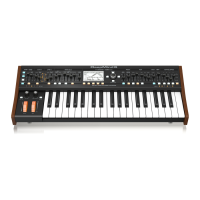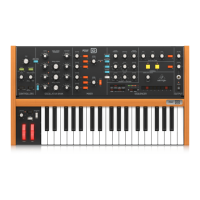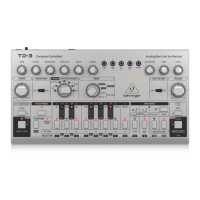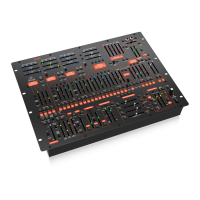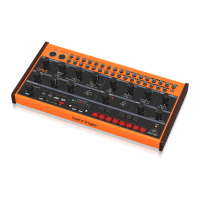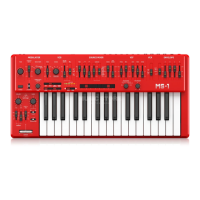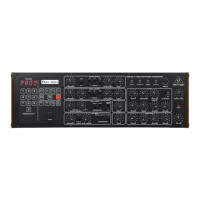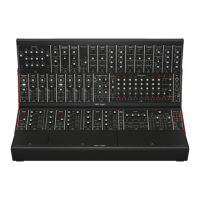148 DeepMind 12 User Manual
Partial: Any of the sinusoidal waveforms which form part of a complex tone.
Patch: The cables used on modular synthesizers (or synthesizers with modular
compatibility) to connect devices together. Patch cables can carry audio, gate or
control voltage signals.
Period: The time that it takes a wave to complete a full cycle. Period is calculated
by dividing 1 by the frequency
Phase: A measurement (in degrees) of the time dierence between two
waveforms, or between a single waveform and a reference point.
Phaser: An eect which uses a series of notched all-pass lters (also called
stages) to create a comb-lter response which does not always have harmonic
relationships between the notches. The result is a sweeping eect similar to a
anger but smoother and often more natural sounding.
Pink Noise: A type of signal that has equal power in each band. Human hearing
is roughly logarithmic, therefore each octave is discerned to have an equal
amount of power across the audible spectrum.
Pitch: A quality of sound that makes it possible to judge if a sound is higher or
lower than another.
Pitch Bend / Pitch Bend Wheel: Controlling the pitch of a note after it has
been played.
Pitch Shift: Alteration of pitch or frequency, but without adjusting tempo.
Pole: A section of a lter stage. The more poles a lter has, the steeper its
attenuation slope will be, and the more accurate the lter will be.
Polyphonic: Capable of playing more than one note at once.
Polyphony: The number of notes a polyphonic synthesizer can play
simultaneously.
Portamento: An adjustable performance eect that glides or bends the pitch
from one note to the next.
Post: The point for accessing audio just after it leaves a specic component or
stage. For example Post-Fader audio is aected by the fader.
Pre: The point for accessing audio just before it reaches a specic component or
stage. For example, Pre-Fader audio is not aected by the fader.
Preset: A program or part of a program that is built into synthesizer patches that
are sometimes xed and sometimes editable.
Program: A complete set of parameters and settings which the synthesizer uses
to create a specic sound.
Power Supply Unit (PSU): The component in a system which is responsible for
supplying and managing power.
Psychoacoustics: The study of the perception of sound, that is, how we
listen, our psychological responses, and the physiological eects on the human
nervoussystem.
Pulse Wave: Similar to a square wave, but without symmetry. Also known as a
"Rectangle Wave."
Pulse Width Modulation (PWM): Modulation of the pulse width (the duty
cycle of a pulse wave measured as a percentage). A pulse width of 50% has equal
positive and negative sections and is considered a square wave.
Q Factor: A bandwidth (or selectivity), of a particular band in an equalizer. The
higher the Q Factor, the wider the bandwidth.
Rate: The speed at which a particular device is operating.
Release Time: The fourth and nal stage of an ADSR envelope. Specied as the
duration of time for an envelope to reach zero after the played key is released.
MIDI (Musical Instrument Digital Interface): A technical standard that
describes a protocol, digital interface and connectors and allows a wide variety of
electronic musical instruments, computers and other related hardware/software
devices to connect and communicate.
MIDI Clock: A clock signal which is broadcast over MIDI to ensure that devices are
synchronised. Also known as MIDI Beat Clock or MIDI Timing Clock.
MIDI Message: Data or information transmitted from one MIDI device to
another. Each MIDI message contains at least two numbers: one that identies
the type of message being sent, and another which represents a value for the
selected type of message.
Midrange: Frequencies in a signal ranging from 250 Hz to 5 kHz
(Approximately B3 to D#8).
Mix: The balance of level between one signal and another.
Mixer: A device that blends input signals into composite signals for output.
Modular Synthesis: A synthesis system comprised of a number of modules
which can be connected in many dierent ways. Modules can perform a single
function such as an oscillator or lter or perform multiple functions.
Modulation: The process of controlling one or more properties (destinations) of
a signal using another signal (source).
Modulation Matrix: A matrix which allows the creation of multiple source to
destination modulations, each with adjustable levels of operation.
Modulation Wheel (Mod Wheel): A wheel located to the left of a keyboard
that allows you to change specied parameters in real-time.
Monitors: Studio quality loudspeakers, providing an accurate representation of
the audio signals.
Mono: A single signal.
Monophonic: Only one note can be played at any given time, as there is only a
single voice.
Mute: Function that allows a signal to be silenced.
N/A: Abbreviation for "not applicable" or "not available".
Noise Generator: A circuit or process that produces a random (or aperiodic)
signal. The frequency response can dier depending on the type of noise.
Note-Priority: Determines which note is played when more notes are held
simultaneously than the number of available voices (often: low/high/last).
Non-Registered Parameter Number (NRPN): A series of controller change
messages used to transmit a parameter change with up to 14-bits of resolution.
Octave or Oct: Unit of measurement for pitch. Every time the frequency of a
waveform doubles, the pitch increases by one octave.
Ohm (Ω):
Unit of electrical resistance.
Oscillator: An electronic device which generates a periodic signal used to form
the basis of a synthesizer program.
One Shot: A single event that has to be triggered each it is required.
Output: The signal sent out by a device or process. Also used to describe the
physical socket where a signal leaves a device.
Overtone: Any frequency that is present in a waveform that is higher than the
fundamental frequency of that waveform.
Pad: A program that is usually characterized by slow attack and release times.
Panning / Pan: The positioning of a signal within a stereo image.
Parameter: A setting whose value can be changed.
Parametric EQ: A type of EQ that allows all of the parameters of equalisation to
be changed, including centre frequency, boost/cut in gain and bandwidth.

